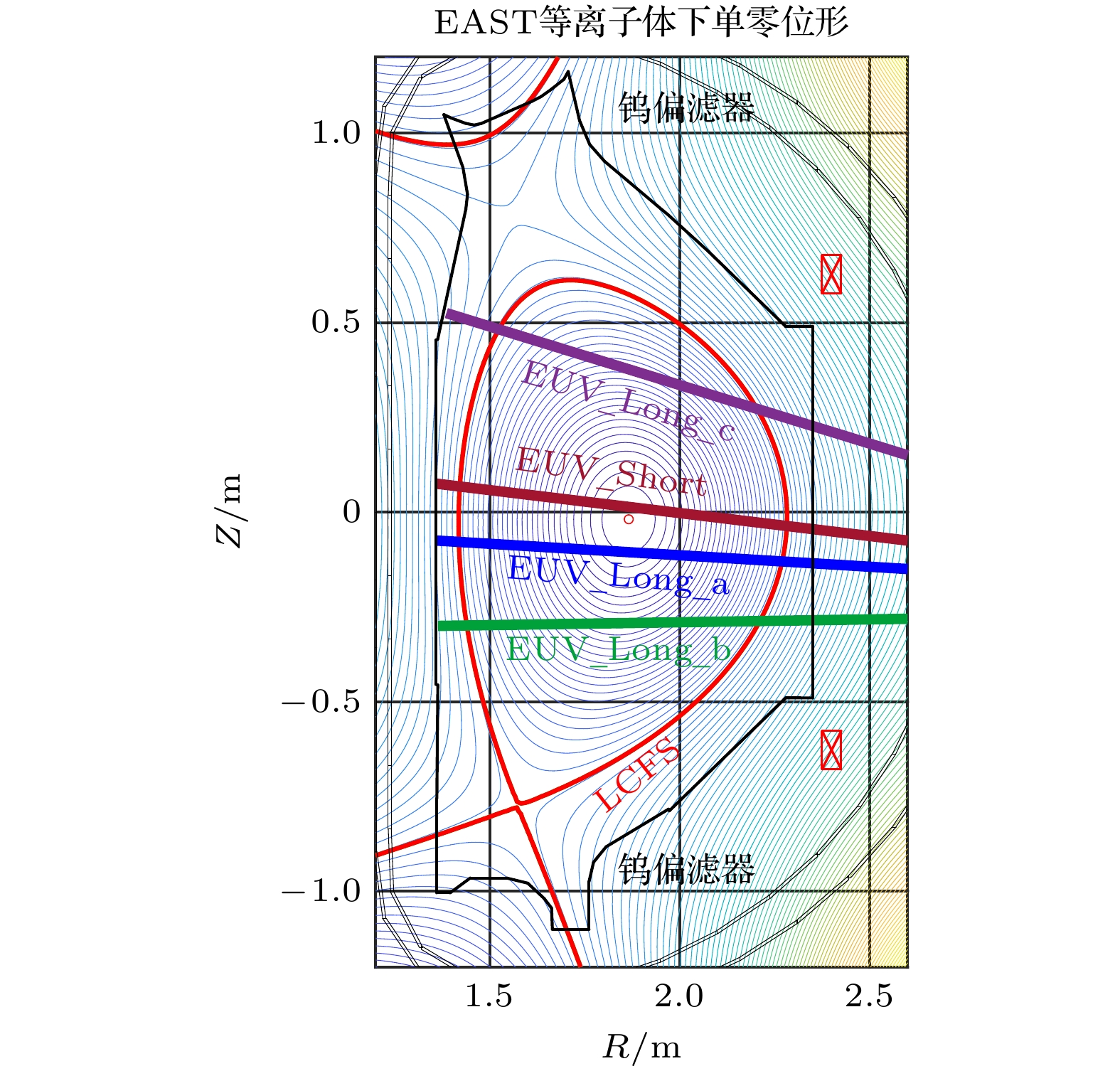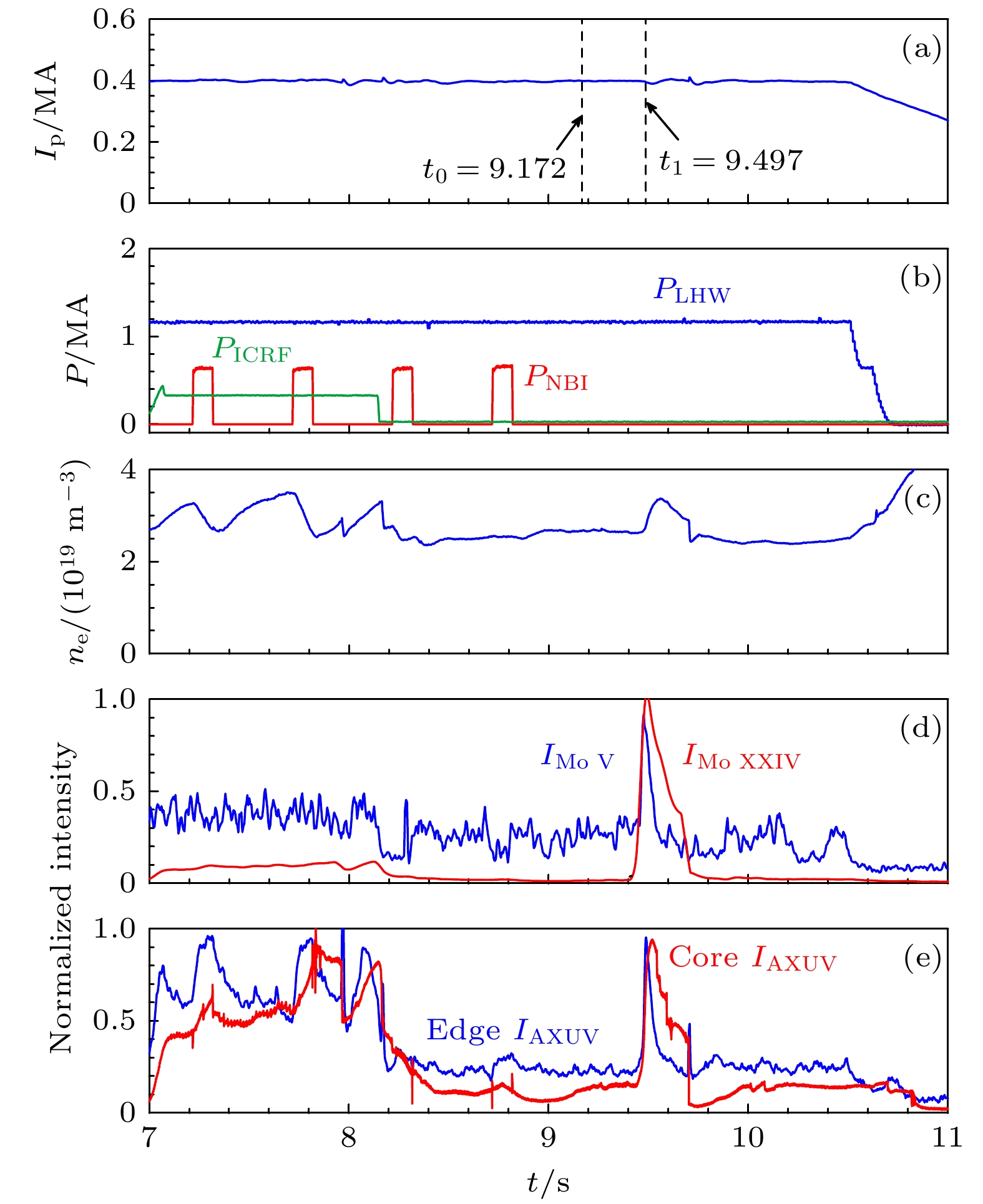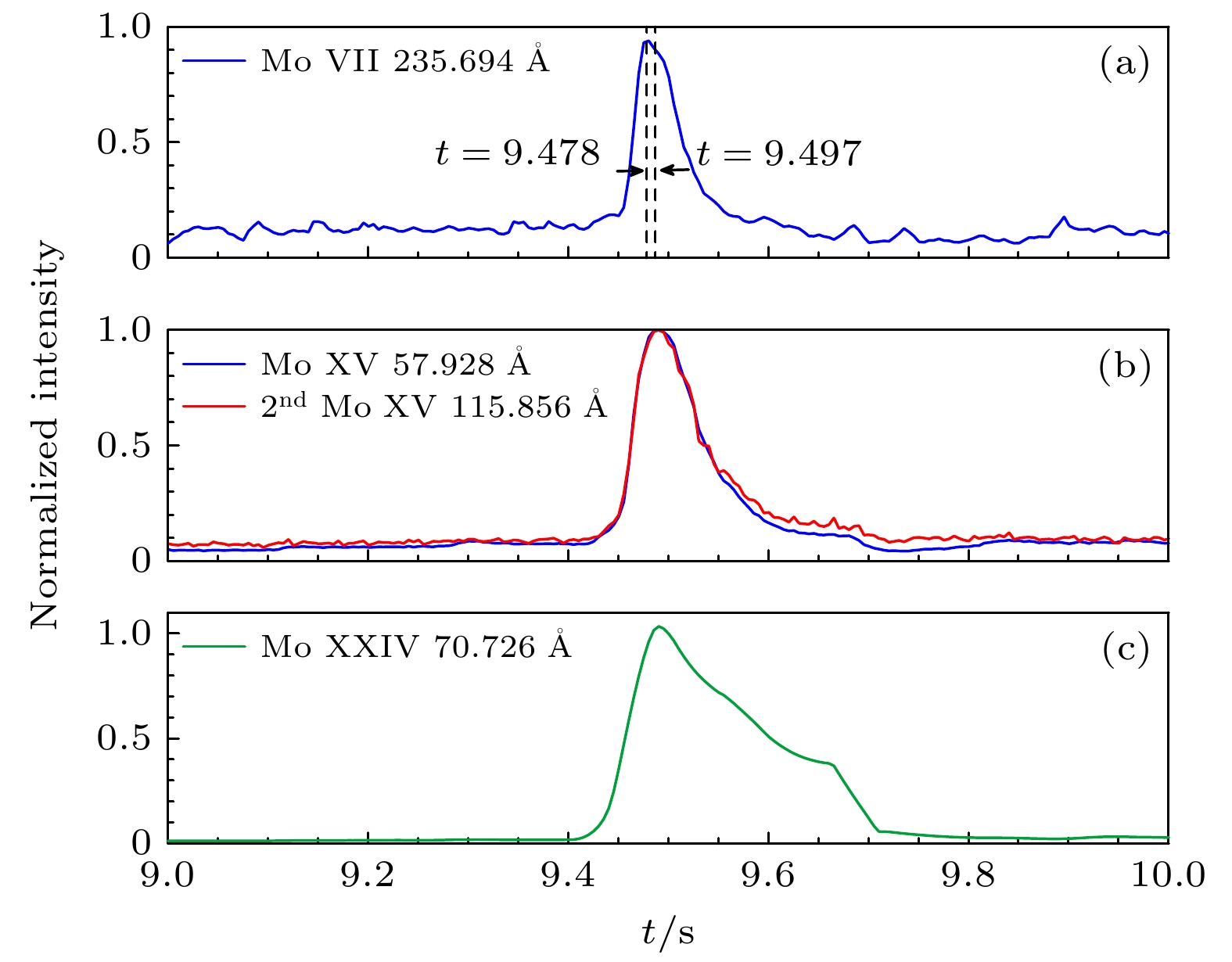-
磁约束聚变等离子体中高Z杂质的存在给等离子体的约束状态带来不同程度的影响. EAST装置第一壁是钼瓦, 不可避免地, 等离子体与壁相互作用会使钼进入等离子体成为高Z杂质. 本文利用EAST托卡马克装置快速极紫外杂质谱仪系统实现了对5—500 Å (1 Å = 0.1 nm)波段范围内杂质线光谱进行同时监测. 结合EAST等离子体低、中Z杂质的特征谱线对波长进行原位标定, 基于NIST数据库和已有实验数据进行对比, 并利用归一化谱线强度随时间演化行为, 对较低电子温度(Te0 = 1.5 keV)等离子体中5—485 Å波段范围内由瞬态钼杂质溅射产生的钼光谱进行了系统性识别. 在15—30 Å和65—95 Å波段范围观测到分别由电离态Mo19+-Mo24+(Mo XX-Mo XXV), Mo16+-Mo29+(Mo XVII-Mo XXX)组成的未分辨跃迁系. 而且在EAST上观测并识别出27—60 Å和120—485 Å波段范围内低价钼离子(Mo4+-Mo17+)的多条谱线(Mo V-Mo XVIII). 这些谱线包含多条强度较强且独立的禁戒线和共振线, 例如Mo XII(329.414 Å, 336.639 Å, 381.125 Å), Mo XIII (340.909 Å, 352.994 Å), Mo XIV(373.647 Å, 423.576 Å), Mo XV(50.448 Å, 57.927 Å, 58.832 Å); 还观测到27—32 Å波段范围内6条新的钼谱线, 即(27.21 ± 0.01) Å, (27.37 ± 0.01) Å, (28.99 ± 0.01) Å, (30.81 ± 0.01) Å, (31.54 ± 0.01) Å, (31.83 ± 0.01) Å, 并推断这6条谱线可能是Mo XV-Mo XVIII谱线. 同时确定了12条用于杂质输运物理研究的谱线. 这些谱线的识别不仅丰富了钼原子数据库, 还为EAST托卡马克开展高Z杂质行为以及输运物理的研究提供了坚实基础.The presence of high-Z impurities in magnetically confined fusion devices has different influences on the confinement property of the plasma due to the high cooling rate of high-Z impurities. The first wall of EAST is equipped with molybdenum tiles, molybdenum particles sputtered from inevitable plasma-wall interaction enter into the plasma and become high-Z impurity. In this paper, four fast-time-response extreme ultraviolet (EUV) spectrometers, a system which is upgraded in the EAST 2021 campaign, are used to monitor the line emission from impurity ions in the 5–500 Å wavelength range simultaneously. The in-situ wavelength calibration is carried out accurately using several well-known emission lines of low- and medium-Z impurity ions. The observed spectral lines are carefully identified based on the National Institute of Standards Technology (NIST) database, previously published experimental data and the time evolution of the normalized line intensity of emission lines from impurity ions. At the lower electron temperature (Te0 = 1.5 keV), the EUV spectra emitted from molybdenum ions in the range of 5–485 Å are systematically identified in EAST discharges accompanied with spontaneous sputtering events. As a result, two unresolved transition arrays of molybdenum spectra composed of Mo19+-Mo24+ (Mo XX-Mo XXV) and Mo16+-Mo29+ (Mo XVII-Mo XXX) are observed in the ranges of 15–30 Å and 65–95 Å. In addition, several spectral lines of lower molybdenum ions of Mo4+-Mo17+ (Mo V-Mo XVIII) in the ranges of 27–60 Å and 120–485 Å are observed and identified on EAST for the first time, including a few strong and isolated forbidden and resonant lines, e.g. Mo XII at 329.414 Å, 336.639 Å and 381.125 Å, Mo XIII at 340.909 Å and 352.994 Å, Mo XIV at 373.647 Å and 423.576 Å, Mo XV at 50.448 Å, 57.927 Å and 58.832 Å. Six spectral lines are newly observed in the range of 27–32 Å, i.e. (27.21 ± 0.01) Å, (27.37 ± 0.01) Å, (28.99 ± 0.01) Å, (30.81 ± 0.01) Å, (31.54 ± 0.01) Å and (31.83 ± 0.01) Å, which may be Mo XV-Mo XVIII spectral lines. As a result, twelve strong and isolated spectral lines are chosen in routine observation for impurity transport physical study. The identification of these spectral lines not only enriches the molybdenum atom database, but also provides a solid experimental data base for magnetically confined devices to study the behavior and transport in core and edge plasmas of high-Z impurity.
[1] Wan B N, Gong X Z, Liang Y, et al. 2022 Nucl. Fusion 62 042010
 Google Scholar
Google Scholar
[2] Gao X, Zeng L, Wu M Q, Zhang T, Yang Y, Ming T F, Zhu X, Wang Y M, Liu H Q, Zang Q, Li G Q, Huang J, Gong X Z, Li Y Y, Li J G, Wan Y X 2020 Nucl. Fusion 60 102001
 Google Scholar
Google Scholar
[3] Zhang L, Morita S, Xu Z, et al. 2017 Nucl. Mater. Energy 12 774
 Google Scholar
Google Scholar
[4] 李加宏, 胡建生, 王小明, 余耀伟, 吴金华, 陈跃, 王厚银 2012 物理学报 61 205203
 Google Scholar
Google Scholar
Li J H, Hu J S, Wang X M, Yu Y W, Wu J H, Chen Y, Wang H Y 2012 Acta Phys. Sin. 61 205203
 Google Scholar
Google Scholar
[5] Gong X Z, Garofalo A M, Huang J, et al. 2019 Nucl. Fusion 59 086030
 Google Scholar
Google Scholar
[6] 张凌, 吴振伟, 高伟, 黄娟, 陈颖杰, 高伟, 胡立群 2013 原子与分子物理学报 30 779
 Google Scholar
Google Scholar
Zhang L, Wu Z W, Gao W, Huang J, Chen Y J, Gao W, Hu L Q 2013 J. At. Mol. Phys. 30 779
 Google Scholar
Google Scholar
[7] Asmussen K, Fournier K B, Laming J M, Neu R, Seely J F, Dux R, Engelhardt W, Fuchs J C 1998 Nucl. Fusion 38 967
 Google Scholar
Google Scholar
[8] Chowdhuri M B, Morita S, Goto M, Nishimura H, Nagai K, Fujioka S 2007 Rev. Sci. Instrum. 78 023501
 Google Scholar
Google Scholar
[9] Huang X L, Morita S, Oishi T, Goto M, Dong C F 2014 Rev. Sci. Instrum. 85 043511
 Google Scholar
Google Scholar
[10] Beiersdorfer P, Magee E W, Träbert E, Chen H, Lepson J K, Gu M F, Schmidt M 2004 Rev. Sci. Instrum. 75 3723
 Google Scholar
Google Scholar
[11] Lepson J K, Beiersdorfer P, Clementson J, Gu M F, Bitter M, Roquemore L, Kaita R, Cox P G, Safronova A S 2010 J. Phys. B:At. Mol. Opt. Phys. 43 144018
 Google Scholar
Google Scholar
[12] Cui Z Y, Morita S, Zhou H Y, et al. 2013 Nucl. Fusion 53 093001
 Google Scholar
Google Scholar
[13] Zhang L, Morita S, Xu Z, et al. 2015 Rev. Sci. Instrum. 86 123509
 Google Scholar
Google Scholar
[14] Xu Z, Zhang L, Cheng Y X, et al. 2021 Nucl. Instrum. Methods Phys. Res. A 1010 165545
 Google Scholar
Google Scholar
[15] Li L, Zhang L, Xu Z, et al. 2021 Plasma Sci. Technol. 23 075102
 Google Scholar
Google Scholar
[16] Chowdhuri M B, Morita S, Goto M, Nishimura H, Nagai K, Fujioka S 2007 Plasma Fusion Res. 2 S1060
 Google Scholar
Google Scholar
[17] Liu Y, Morita S, Oishi T, Goto M, Huang X L 2018 Plasma Fusion Res. 13 3402020
 Google Scholar
Google Scholar
[18] Schwob J L, Klapisch M, Schweitzer N, Finkenthal M, Breton C, Michelis C D, Mattioli M 1977 Phys. Lett. A 62 85
 Google Scholar
Google Scholar
[19] Jupén C, Denne-Hinnov B, Martinson I, Curtis L J 2003 Phys. Scr. 68 230
 Google Scholar
Google Scholar
[20] 杨友磊, 胡叶民, 项农 2017 物理学报 24 245202
 Google Scholar
Google Scholar
Yang Y L, Hu Y M, Xiang N 2017 Acta Phys. Sin. 24 245202
 Google Scholar
Google Scholar
[21] 洪斌斌, 陈少永, 唐昌建, 张新军, 胡有俊 2012 物理学报 61 115207
 Google Scholar
Google Scholar
Hong B B, Chen S Y, Tang C J, Zhang X J, Hu Y J 2012 Acta Phys. Sin. 61 115207
 Google Scholar
Google Scholar
[22] Wan B N, Li J G, Guo H Y, Liang Y F, Xu G S, Wang L, Gong X Z 2015 Nucl. Fusion 55 104015
 Google Scholar
Google Scholar
[23] 姚黎明, 张凌, 许棕, 杨秀达, 吴承瑞, 张睿瑞, 杨飞, 吴振伟, 姚建铭, 龚先祖, 胡立群 2019 光谱学与光谱分析 39 2645
 Google Scholar
Google Scholar
Yao L M, Zhang L, Xu Z, Yang X D, Wu C R, Zhang R R, Yang F, Wu Z W, Yao J M, Gong X Z, Hu L Q 2019 Spectrosc. Spect. Anal. 39 2645
 Google Scholar
Google Scholar
[24] 杨秀达, 张凌, 许棕, 张鹏飞, 陈颖杰, 黄娟, 吴振伟, 龚先祖, 胡立群 2018 光谱学与光谱分析 38 1262
 Google Scholar
Google Scholar
Yang X D, Zhang L, Xu Z, Zhang P F, Chen Y J, Huang J, Wu Z W, Gong X Z, Hu L Q 2018 Spectrosc. Spect. Anal. 38 1262
 Google Scholar
Google Scholar
[25] Kramida A, Ralchenko Y, Reader J 2021 NIST Atomic Spectra Database 78 https://dx.doi.org/10.18434/T4 W30 F
[26] Duan Y M, Hu L Q, Mao S T, Xu P, Chen K Y, Lin S Y, Zhong G Q, Zhang J Z, Zhang L, Wang L 2011 Plasma Sci. Technol. 13 546
 Google Scholar
Google Scholar
[27] Klapisch M, Schwob J L, Finkenthal M, Fraenkel B S, Egert S, Bar-Shalom A, Breton C, DeMichelis C, Mattioli M 1978 Phys. Rev. Lett. 41 403
 Google Scholar
Google Scholar
[28] Zhang L, Morita S, Wu Z W, et al. 2019 Nucl. Instrum. Methods Phys. Res. A 916 169
 Google Scholar
Google Scholar
[29] 程云鑫, 张凌, 吴振伟, 许棕, 杨秀达, 黎缧 2020 核聚变与等离子体物理 40 262
 Google Scholar
Google Scholar
Cheng Y X, Zhang L, Wu Z W, Xu Z, Yang X D, Li L 2020 Nucl. Fusion Plasma Phys. 40 262
 Google Scholar
Google Scholar
-
图 3 发生钼杂质溅射的典型波形图 (a) 等离子体电流Ip; (b) 低杂波、离子回旋和中性束加热功率(PLHW, PICRF, PNBI); (c) 芯部弦平均电子密度ne; (d) 归一化的Mo V 258.069 Å和Mo XXIV 70.726 Å线辐射强度(IMo V, IMo XXIV); (e) 归一化的边界辐射和芯部辐射强度(Edge IAXUV, Core IAXUV)
Fig. 3. Typical waveform of discharge with molybdenum impurity sputtering: (a) plasma current, Ip; (b) heating power of low hybrid wave, PLHW, ion cyclotron range of frequency heating, PICRF, and neutral beam injection, PNBI; (c) central line-averaged electron density, ne; (d) normalized intensities of Mo V at 258.069 Å, IMo V, and Mo XXIV at 70.726 Å, IMo XXIV; (e) normalized radiation intensities observed by fast AXUV system along an edge and central chord, Edge IAXUV, and Core IAXUV, respectively.
图 5 EAST #101700放电钼杂质爆发前325 ms(灰色线, t = 9.172 s)和爆发期间(蓝色线, t = 9.497 s)观测5—485 Å波段范围的EUV光谱 (a) 5—45 Å; (b) 45—165 Å; (c) 165—285 Å; (d) 285—485 Å
Fig. 5. EUV spectra observed 325 ms before (grey lines, t = 9.172 s) and during (blue lines, t = 9.497 s) the molybdenum burst at the wavelength ranges of 5–485 Å in EAST discharge #101700: (a) 5–45 Å; (b) 45–165 Å; (c) 165–285 Å; (d) 285–485 Å.
图 6 EAST #101700放电中四条钼离子归一化谱线强度随时间的演化 (a) Mo VII 235.694 Å; (b) Mo XV 57.928 Å, 2nd Mo XV 115.856 Å; (c) Mo XXIV 70.726 Å
Fig. 6. Time evolutions of the four molybdenum ions normalized line emission intensities in EAST #101700 discharge: (a) Mo VII at 235.694 Å; (b) Mo XV at 57.928 Å and 2nd Mo XV at 115.856 Å; (c) Mo XXIV at 70.726 Å.
表 1 在EUV波段识别的钼谱线
Table 1. Identified molybdenum lines in EUV range.
谱线 离子 电离能/eV 波长/Å 跃迁能级 实验值 参考值 Mo V Mo4+ 54.42 258.09 ± 0.03 258.069 4p54d3 3 → 4p64d2 1D2 324.98 ± 0.02 324.979 4p64d5f 3H°4 → 4p64d2 3F4 327.13 ± 0.01 327.167 4p54d3 3 → 4p64d2 3P2 Mo VI Mo5+ 68.83 227.75 ± 0.04 227.801 4p5(2P°)4d(3F)5s 2F°5/2→4p64d 2D5/2 229.20 ± 0.04 229.262 4p66f 2F°5/2 →4p64d 2D3/2 Mo VII Mo6+ 125.64 151.85 ± 0.04 151.747 4s24p5(2P°3/2)5d 2[1/2] °1 → 4s24p6 1S0 235.66 ± 0.05 235.694 4s24p5(2P°3/2)5f 2[3/2]1 → 4s24p5(2P°1/2)4d 2[3/2]°2 Mo VIII Mo7+ 143.6 133.18 ± 0.03 133.168 4s24p4(3P)5d 2P3/2→4s24p5 2P°3/2 134.34 ± 0.03 134.362 4s24p4(3P)5d 4F5/2→4s24p5 2P°3/2 136.83 ± 0.03 136.782 4s24p4(3P)5d 2D3/2→4s24p5 2P°3/2 Mo IX Mo8+ 164.12 132.03 ± 0.03 132.077 4s24p3(2P°)5d 3P°1→4s24p4 1S0 158.53 ± 0.03 158.641 4s24p3(2P°1/2)5s (1/2, 1/2)°1→4s24p4 3P2 176.67 ± 0.04 176.682 4s24p3(2D°3/2)5s (3/2, 1/2)°2→4s24p4 1D2 231.90 ± 0.05 231.991 4s24p3(2D°)4d 1F°3→4s24p4 1D2 237.76 ± 0.05 237.843 4s24p3(2D°)4d 1D°2→4s24p4 1D2 Mo X Mo9+ 186.3 152.54 ± 0.04 152.683 4s24p2(3P)5s 4P3/2 →4s24p3 4S°3/2 157.65 ± 0.04 157.624 4s24p2(3P)5s 2P3/2 →4s24p3 2D°5/2 159.07 ± 0.04 159.049 4s24p2(3P)5s 4P5/2 →4s24p3 2D°5/2 159.42 ± 0.04 159.219 4s24p2(3P)5s 4P3/2 →4s24p3 2D°3/2 231.07 ± 0.04 231.110 4s24p2(1D)4d 2F7/2 →4s24p3 2D°5/2 239.03 ± 0.06 239.017 4s24p2(1S)4d 2D5/2 →4s24p3 2P°3/2 243.05 ± 0.06 243.071 4s24p2(1D)4d 2D3/2→4s24p3 2D°5/2 Mo XI Mo10+ 209.3 146.65 ± 0.04 146.641 4s24p (2P°1/2)5s (1/2, 1/2)°1→4s24p2 3P2 322.12 ± 0.04 322.158 4s4p3 1P°1 → 4s24p2 1D2 Mo XII Mo11+ 230.28 131.37 ± 0.03 131.394 4s25s 2S1/2→4s24p 2P°1/2 250.09 ± 0.06 250.112 4s24d 2D5/2→4s24p 2P°3/2 329.53 ± 0.01 329.414 4s4p2 2P3/2→4s24p 2P°3/2 336.51 ± 0.01 336.639 4s4p2 2P1/2→4s24p 2P°3/2 381.13 ± 0.06 381.125 4s4p2 2D3/2→4s24p 2P°1/2 Mo XIII Mo12+ 279.1 53.56 ± 0.02 53.551 3d94s24p 3D°1→3d104s2 1S0 54.12 ± 0.02 54.101 3d94s24p 1P°1→3d104s2 1S0 340.88 ± 0.01 340.909 3d104s4p 1P°1→3d104s2 1S0 352.87 ± 0.03 352.994 3d104p2 3P1→3d104s4p 3P°0 Mo XIV Mo13+ 302.6 51.98 ± 0.02 52.000 3d9(2D)4p2(3P) 2P1/2→3d104p 2P°3/2 52.77 ± 0.02 52.753 3d9(2D)4s4p (3P°) 2P°3/2→3d104s 2S1/2 121.68 ± 0.02 121.647 3d105s 2S1/2→3d104p 2P°3/2 241.78 ± 0.06 241.609 3d104d 2D3/2→3d104p 2P°1/2 373.55 ± 0.05 373.647 3d104p 2P°3/2→3d104s 2S1/2 423.57 ± 0.07 423.576 3d104p 2P°1/2→3d104s 2S1/2 Mo XV Mo14+ 544 29.48 ± 0.01 29.458 3d95f 1P°1→3d10 1S0 29.81 ± 0.01 29.774 3d95f 3D°1→3d10 1S0 35.39 ± 0.01 35.368 3d94f 1P°1→3d10 1S0 50.43 ± 0.02 50.448 3d9(2D5/2)4p (5/2, 3/2)°1→3d10 1S0 58.04 ± 0.04 57.927 3d9(2D3/2)4s (3/2, 1/2) 2→3d10 1S0 58.86 ± 0.04 58.832 3d9(2D5/2)4s (5/2, 1/2) 2→3d10 1S0 347.47 ± 0.05 347.339 3d9(2D5/2)4p (5/2, 3/2)°3→3d9(2D5/2)4s (5/2, 1/2)3 365.77 ± 0.04 365.924 3d9(2D5/2)4p (5/2, 3/2)4→3d9(2D5/2)4s (5/2, 1/2)3 Mo XVI Mo15+ 591 32.92 ± 0.05 32.916 3p63d8(1G4)4f 2[1]°3/2→3p63d9 2D5/2 34.03 ± 0.01 33.992 3p63d8(3F2)4f 2[1]°3/2→3p63d9 2D3/2 54.46 ± 0.03 54.348 3p63d8(3F4)4s (4, 1/2) 9/2→3p63d9 2D5/2 Mo XVIII Mo17+ 702 38.81 ± 0.01 38.700a 3d64p→3d7 a 数据来源于文献[18], 其他数据来源于NIST数据库[25], 粗体表示可用于杂质诊断的谱线. -
[1] Wan B N, Gong X Z, Liang Y, et al. 2022 Nucl. Fusion 62 042010
 Google Scholar
Google Scholar
[2] Gao X, Zeng L, Wu M Q, Zhang T, Yang Y, Ming T F, Zhu X, Wang Y M, Liu H Q, Zang Q, Li G Q, Huang J, Gong X Z, Li Y Y, Li J G, Wan Y X 2020 Nucl. Fusion 60 102001
 Google Scholar
Google Scholar
[3] Zhang L, Morita S, Xu Z, et al. 2017 Nucl. Mater. Energy 12 774
 Google Scholar
Google Scholar
[4] 李加宏, 胡建生, 王小明, 余耀伟, 吴金华, 陈跃, 王厚银 2012 物理学报 61 205203
 Google Scholar
Google Scholar
Li J H, Hu J S, Wang X M, Yu Y W, Wu J H, Chen Y, Wang H Y 2012 Acta Phys. Sin. 61 205203
 Google Scholar
Google Scholar
[5] Gong X Z, Garofalo A M, Huang J, et al. 2019 Nucl. Fusion 59 086030
 Google Scholar
Google Scholar
[6] 张凌, 吴振伟, 高伟, 黄娟, 陈颖杰, 高伟, 胡立群 2013 原子与分子物理学报 30 779
 Google Scholar
Google Scholar
Zhang L, Wu Z W, Gao W, Huang J, Chen Y J, Gao W, Hu L Q 2013 J. At. Mol. Phys. 30 779
 Google Scholar
Google Scholar
[7] Asmussen K, Fournier K B, Laming J M, Neu R, Seely J F, Dux R, Engelhardt W, Fuchs J C 1998 Nucl. Fusion 38 967
 Google Scholar
Google Scholar
[8] Chowdhuri M B, Morita S, Goto M, Nishimura H, Nagai K, Fujioka S 2007 Rev. Sci. Instrum. 78 023501
 Google Scholar
Google Scholar
[9] Huang X L, Morita S, Oishi T, Goto M, Dong C F 2014 Rev. Sci. Instrum. 85 043511
 Google Scholar
Google Scholar
[10] Beiersdorfer P, Magee E W, Träbert E, Chen H, Lepson J K, Gu M F, Schmidt M 2004 Rev. Sci. Instrum. 75 3723
 Google Scholar
Google Scholar
[11] Lepson J K, Beiersdorfer P, Clementson J, Gu M F, Bitter M, Roquemore L, Kaita R, Cox P G, Safronova A S 2010 J. Phys. B:At. Mol. Opt. Phys. 43 144018
 Google Scholar
Google Scholar
[12] Cui Z Y, Morita S, Zhou H Y, et al. 2013 Nucl. Fusion 53 093001
 Google Scholar
Google Scholar
[13] Zhang L, Morita S, Xu Z, et al. 2015 Rev. Sci. Instrum. 86 123509
 Google Scholar
Google Scholar
[14] Xu Z, Zhang L, Cheng Y X, et al. 2021 Nucl. Instrum. Methods Phys. Res. A 1010 165545
 Google Scholar
Google Scholar
[15] Li L, Zhang L, Xu Z, et al. 2021 Plasma Sci. Technol. 23 075102
 Google Scholar
Google Scholar
[16] Chowdhuri M B, Morita S, Goto M, Nishimura H, Nagai K, Fujioka S 2007 Plasma Fusion Res. 2 S1060
 Google Scholar
Google Scholar
[17] Liu Y, Morita S, Oishi T, Goto M, Huang X L 2018 Plasma Fusion Res. 13 3402020
 Google Scholar
Google Scholar
[18] Schwob J L, Klapisch M, Schweitzer N, Finkenthal M, Breton C, Michelis C D, Mattioli M 1977 Phys. Lett. A 62 85
 Google Scholar
Google Scholar
[19] Jupén C, Denne-Hinnov B, Martinson I, Curtis L J 2003 Phys. Scr. 68 230
 Google Scholar
Google Scholar
[20] 杨友磊, 胡叶民, 项农 2017 物理学报 24 245202
 Google Scholar
Google Scholar
Yang Y L, Hu Y M, Xiang N 2017 Acta Phys. Sin. 24 245202
 Google Scholar
Google Scholar
[21] 洪斌斌, 陈少永, 唐昌建, 张新军, 胡有俊 2012 物理学报 61 115207
 Google Scholar
Google Scholar
Hong B B, Chen S Y, Tang C J, Zhang X J, Hu Y J 2012 Acta Phys. Sin. 61 115207
 Google Scholar
Google Scholar
[22] Wan B N, Li J G, Guo H Y, Liang Y F, Xu G S, Wang L, Gong X Z 2015 Nucl. Fusion 55 104015
 Google Scholar
Google Scholar
[23] 姚黎明, 张凌, 许棕, 杨秀达, 吴承瑞, 张睿瑞, 杨飞, 吴振伟, 姚建铭, 龚先祖, 胡立群 2019 光谱学与光谱分析 39 2645
 Google Scholar
Google Scholar
Yao L M, Zhang L, Xu Z, Yang X D, Wu C R, Zhang R R, Yang F, Wu Z W, Yao J M, Gong X Z, Hu L Q 2019 Spectrosc. Spect. Anal. 39 2645
 Google Scholar
Google Scholar
[24] 杨秀达, 张凌, 许棕, 张鹏飞, 陈颖杰, 黄娟, 吴振伟, 龚先祖, 胡立群 2018 光谱学与光谱分析 38 1262
 Google Scholar
Google Scholar
Yang X D, Zhang L, Xu Z, Zhang P F, Chen Y J, Huang J, Wu Z W, Gong X Z, Hu L Q 2018 Spectrosc. Spect. Anal. 38 1262
 Google Scholar
Google Scholar
[25] Kramida A, Ralchenko Y, Reader J 2021 NIST Atomic Spectra Database 78 https://dx.doi.org/10.18434/T4 W30 F
[26] Duan Y M, Hu L Q, Mao S T, Xu P, Chen K Y, Lin S Y, Zhong G Q, Zhang J Z, Zhang L, Wang L 2011 Plasma Sci. Technol. 13 546
 Google Scholar
Google Scholar
[27] Klapisch M, Schwob J L, Finkenthal M, Fraenkel B S, Egert S, Bar-Shalom A, Breton C, DeMichelis C, Mattioli M 1978 Phys. Rev. Lett. 41 403
 Google Scholar
Google Scholar
[28] Zhang L, Morita S, Wu Z W, et al. 2019 Nucl. Instrum. Methods Phys. Res. A 916 169
 Google Scholar
Google Scholar
[29] 程云鑫, 张凌, 吴振伟, 许棕, 杨秀达, 黎缧 2020 核聚变与等离子体物理 40 262
 Google Scholar
Google Scholar
Cheng Y X, Zhang L, Wu Z W, Xu Z, Yang X D, Li L 2020 Nucl. Fusion Plasma Phys. 40 262
 Google Scholar
Google Scholar
计量
- 文章访问数: 2766
- PDF下载量: 68
- 被引次数: 0














 下载:
下载:





